|
10 August 2006
Media Disinformation
On Wednesday August 9th 2006, Amy Goodman reported:
“Former Israeli Air Force Captain Reports Israeli Pilots Deliberately Missing Targets Over Concerns of Civilian Casualties.”
Fox news reported: “I don’t think Israel is really bombing Lebanon, I think it is faulty construction that is causing these buildings to fall.” See 1 minute video here.
British media tell us that “200 Hezbollah” rockets were fired without mentioning that, eg., 4000 Israeli bombs were dropped in 250 air attacks within seven hours.
From Hanady Salman1
Beirut August the 9th
When I went home last night, I rushed to Kinda’s bed as usual. I pulled her arm and kissed her hand. For a second, I thought that her arm remained in my hand. Her small white arm left her shoulder and was in my hand. Suddenly she became parts and bits. Her foot was at one end of the bed, her leg was at the other. Parts and bits. My baby is nothing but parts and bits. Now, today, she is still in one piece. What is it that will prevent them from tearing her apart? What is it I can do to prevent them from tearing her apart?
Baby Waad has in her mother’s arms. She stayed there when the building fell on them. It was the rescuer who separated them. Waad died in one piece. Too small to be cut in two: she is, was, ten days old. From the mother, only one arm remained.
They killed baby Hadi too. He had his diapers on. His mother should have known better. She should have changed his diaper; it looked really heavy in the morgue.
They killed baby Manal. Baby Mohamad, baby Ali, baby every single name in the Arabic language. Those they missed here, they killed in Palestine.
“ya Ali” , the man was calling in Srifa. “Ya Ali, Ya batal” . That’s how he was calling his son, “hero”. The hero never answered back. The hero was under the rubble. Along others who are still under the rubble in Srifa. Along others who are still under the rubble in Houla, Aynatha, Aytaroun, Hallousiyeh, Taybeh, Maroon el Ras, Bint Jbeil. People are rotting under the rubble in every single village south of the Litany River in Southern Lebanon.
There was a day, at the beginning of this, when we felt sorry for those who lost their homes. Reporters would use their best writing skills to describe how bad one might feel if one looses one’s house: in houses, there are photo albums, there are books, music, and “memories”, the reporters said. It is not poetic to mention winter clothes, kitchen utensils, underwear, fridges, heaters, air conditioners, cars and other trivial details people in poor neighborhoods spend years saving to get. Talking about left behind medicine, Ids, deeds, medical reports, birth certificates and other “vital” stuff is more likely to move the readers.
Today, under the rubble, the house owners vanish. Forever they will keep their books, their music, their photos, their winter clothes, their medicine; they can hug their kids indefinitely.
Under the rubble, one village after the other, one house after the other, memories take their owners along. Ashes.
Pity the living, pity those who are left behind. Pity those who are dreading the day when it will be their turn to run down the streets, screaming, collecting the legs and arms of their loved ones, calling their names so loud their voices would reach the skies.”
Hanady
The Red Cross, on 7 August, said that “The Israeli military has denied permission for aid groups to move food and medicine to besieged villages in southern Lebanon for two days.” Robert Fisk (09.08.06) observes that “Israel’s Promise of Humanitarian Corridors Is Exposed as a Myth.” Hanady writes today (10 August): “Most hospitals announced they finished their fuel reserves. There’s a ship loaded with fuel that came all the way from Algeria and has been waiting in the Lebanese (poisoned) waters for days for an Israeli OK to come in. In the newspaper, the two generators we have are out of order and they’re cutting the electricity in some 15 minutes. So, I’m writing this in a hurry.”
The Guardian (10.08.06) casualty chart notes:
Lebanon yesterday:
To date:
Israel yesterday:
To date:
Civilians killed:
Civilians killed:
Civilians killed:
Civilians killed:
8 (at least)
1,005
0
35
The bodies of those still lying underneath the rubble are not included. Perhaps the Fox News Team should be sent to help dig them out, despite the Israeli restrictions on any form of movement.
Let’s have a reality check, folks? I would like everyone to see the photographs, with their captions, that have been sent to me by Lebanon’s As-Safir newspaper
(TO SEE ENLARGED PHOTOS GO TO http://indexresearch.blogspot.com/.).
Photo Album
Here’s what they did to Brital in the Bekaa, East Lebanon.
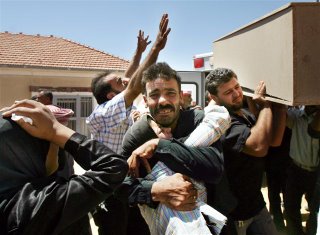  1.Mourners react while the coffins of 1.Mourners react while the coffins of
their relatives, who were killed in an
Israeli attack, are carried towards the cemetery.(ap)
2.struck by Israeli war plane missiles at the village of Brital
in the eastern Bekaa Valley, Lebanon Tuesday, Aug. 8.(ap)
 
3. blood stains at a partly demolished
house that was struck by Israeli war
plane missiles at the village of Brital.(ap)
4.Dar El Amal in hospital after his house, along with
others, was struck by Israeli war plane missiles in
the village of Brital.(ap)
Here’s what they did to Manal Husseini in Ghaziyeh in the south.
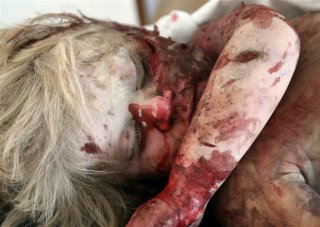 1.Manal al-Husseini, 3, lies dead at Al Raeh hospital 1.Manal al-Husseini, 3, lies dead at Al Raeh hospital
morgue after an Israeli air strike on Ghaziyeh
village, south Lebanon.(reuters)
Hadi Jaafar.
 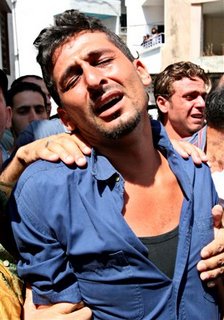 1.The father of Lebanese Hadi 1.The father of Lebanese Hadi
Jaafar, 2, cries during the funeral
of his son.(ap)
2.Lebanese Hadi Jaafar, 2, lies on the floor as he is prepared to be buried in the southern town of Ghaziyeh. (ap)
  3.father of Lebanese Hadi Jaafar, 2, 3.father of Lebanese Hadi Jaafar, 2,
kisses his son’s wrapped body during the mass funeral of Lebanese civilians.(ap) 4.Lebanese mourners carry the body
of Lebanese Hadi Jaafar, 2.(ap)
Baby Waad, 10 days old
  1.Lebanese Abbas Wehbeh shouts 1.Lebanese Abbas Wehbeh shouts
while holding his 10 day old neice, Waad, 8 August(ap)
2.Here’s what they did to baby Waad in her tenth day, while she was in her mother’s arms.(ap)
Here’s what they did in Chiyah , Beirut
  1.Lebanese Red Cross volunteers 1.Lebanese Red Cross volunteers
and civil defense rescuers carry
the body of a child after it was
recovered.(safir)
2.Aida Kanj(afp)
  3.Body of a victim August 8 amidst 3.Body of a victim August 8 amidst
the wreckage of a building that was
hit by an Israeli raid in Beirut.(safir)
4.Hussein Rmeity, 9, suffering from
head trauma and brain contusion
rests in the intensive care unit.(ouc)
  5.Hassan Al Raai rests in the 5.Hassan Al Raai rests in the
intensive care unit of Hayat
hospital in the Chiah suburb
of Beirut.(safir)
6.A Lebanese youth shows the
body of a baby after it was
recovered under debris of a
destroyed building (afp)
This is what they did to Ghaziyeh
  2.Mourning during a mass funeral 2.Mourning during a mass funeral
of Lebanese citizens at the
southern town of Ghaziyeh, near
the port city of Sidon, Lebanon.(ap) 1.Lebanese mourners scream slogans
as they carry the bodies of relatives
for burial in Ghaziyeh, south Lebanon.(reuters)
  3.Mourner holds a copy of the Quran, Islam’s holy book, in front of wrapped bodies of civilians during a mass funeral.(safir) 3.Mourner holds a copy of the Quran, Islam’s holy book, in front of wrapped bodies of civilians during a mass funeral.(safir)
4.Signals to colleagues that he found three bodies under the rubble after an Israeli air strike on Ghaziyeh village.(ap)
  5.Two Lebanese women mourn.(ap) 5.Two Lebanese women mourn.(ap)
6.Women mourn during the mass funeral of Lebanese civilians at the southern town of Ghaziyeh.(ap)
  7.A Lebanese woman lies in hospital.(safir) 7.A Lebanese woman lies in hospital.(safir)
8.Lebanese man mourns during the mass funeral of Lebanese civilians at the southern town of Ghaziyeh.(safir)
In Sour: The mighty power from above, leaflets and refugees


1.On debel(safir)
2.Leaflets(safir)
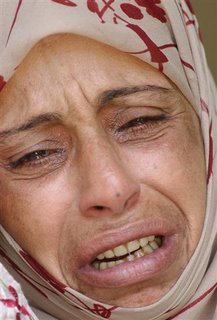 
3.Fatmeh Abdallah(safir)
4.To the refugee camp(safir)
Sabrine Hayek

1.Sabrine Hayek, aged 10, lies on her hospital bed in the Lebanese village of Adloun(afp)
Refugees Hosting Refugees
“In Bass Palestinian refugees camp in Tyre, southerners took refuge. They say the Palestinians are going out of their way to make them feel at home: they borrow money and  use their savings to buy them food. The Palestinians say this is the minimum they can do for those who had been hosting them on their land for 50 years. It takes a refugee to know what it means to be one.” Hanady use their savings to buy them food. The Palestinians say this is the minimum they can do for those who had been hosting them on their land for 50 years. It takes a refugee to know what it means to be one.” Hanady
1.om Bassam and grandchildren.(safir)
 
2.Palestinian women om qassem
prepare food. (safir)
3.Refugees in Tyre Palestinian camp.(safir)
Ethnic Cleansing
“Those who had so far been unable to leave their homes in the southern suburb did so today. They believed the warning the state of israel threw over the capital today, saying they had to leave their homes because they intended to bomb them.” Hanady.
 
1.A Lebanese woman sits on the
street waiting to leave Beirut.(safir)
2.Out of the suburb(safir)
 
3.Woman and her ailing husband
flee with their grandchildren(safir)
4.Woman carries her belongings
as she walks with her child(safir)

5.Woman sits on the street(safir)
Elsewhere in Lebanon
 
1.The old lighthouse next to my house(safir)
2.Southern suburbs of Beirut:
men look at a rocket.(afp)
  4.Mouawad after a night raid(safir) 4.Mouawad after a night raid(safir)
5.Baalbeck: a truck burns(Reuters)
Tyre
“Tyre was like a ghost town : the streets were empty, the fishermen did not go to work , the schools were trying to accommodate more people and the animals searched for food in garbage.” Hanady
 
1.Tyre: the hungry horse.(safir)
2.Tyre: empty corniche(safir)
This is how our kids play

1.Displaced Lebanese children.(safir)
Long live the people of the world.

1. Pakistani Christian women light candles during a special prayer service for the Lebanese victims of Israeli air strike.(ao)
+
Those who have been sitting around tables in suits working on a Peace Plan have famously fiddled. To know about some of those who have been helpful, please see 9 min. video here – and Medecins Sans Frontieres.
+
The Geneva Conventions
Protocol I, Article 85, Section 3 of the Geneva Convention: “An indiscriminate attack affecting the civilian population or civilian objects and resulting in excessive loss of life, injury to civilians or damage to civilian objects is a grave breach of the Geneva Conventions.”
Article 15. At all times, and particularly after an engagement, Parties to the conflict shall, without delay, take all possible measures to search for and collect the wounded and sick, to protect them against pillage and ill-treatment, to ensure their adequate care, and to search for the dead and prevent their being despoiled.
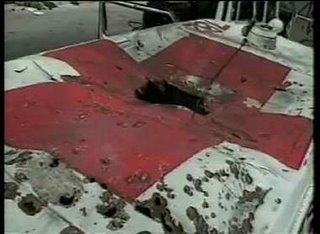
Article 19: Fixed establishments and mobile medical units of the Medical Service may in no circumstances be attacked.
Article 35. Transports of wounded and sick or of medical equipment shall be respected and protected in the same way as mobile medical units.
+
Note
[1] Hanady Salman is a journalist with As-Safir, Lebanon.
The URL to DEATH IN LEBANON is: http://indexresearch.blogspot.com/2006/08/death-in-lebanon.html
Email: [email protected]
|